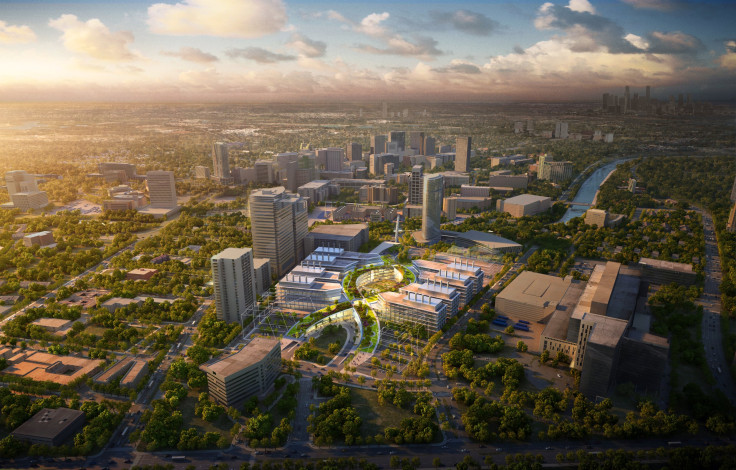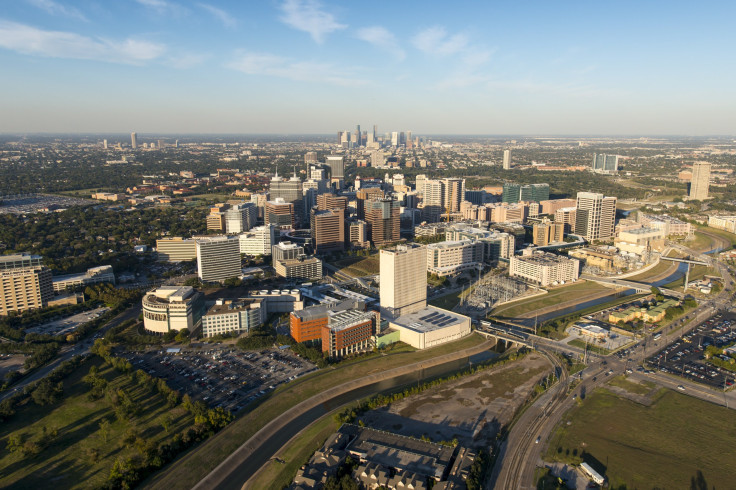Oil Crisis: As Prices Plunge, Houston Launches $2 Billion Plan To Become ‘Third Coast’ For Biotech

If all goes according to plan, future travelers to Houston who glance out an airplane’s window will see the soft curves of a giant double helix etched into the ground below. This mega-DNA will serve as a Texas-size signal that the city, famous for its oil and gas riches, is eager to embrace another industry — the life sciences — to insulate itself against volatile oil prices.
In Houston, medical leaders are pursuing a bold idea to build a $2 billion, 30-acre commercialization campus in the center of Houston’s healthcare industry. With energy jobs dwindling and the local economy on the brink of a recession, the proposal couldn’t come at a better time. The city hopes this beating heart for innovation, complete with a four-star hotel and DNA-shaped park, will spur a life sciences sector to rival those of other biotech capitals such as Boston, Seattle and Durham, North Carolina.
Though the project is only in the earliest fundraising stages, corporate partners are starting to bite — AT&T opens a research center dedicated to digital health in Houston this month, and Johnson & Johnson unveils its newest biotech incubator, known as JLabs, March 2.
Cities dependent on crude across the U.S. have increasingly sought to diversify their economies as oil prices have fallen over the past year, with varying degrees of success. On the one hand, Fargo, North Dakota, was named the top-performing small city of 2015 by the think tank Milken Institute for developing an oil economy that also has strong roots in finance, insurance, health and higher education. Dallas, Texas, which placed fifth among large cities, weaned itself from oil partly by welcoming business services and supporting a healthy slate of technology companies. But others have struggled — Anchorage, Alaska, dropped 58 places in the annual rankings last year and expects to lose 1,600 more jobs in 2016, mostly from the energy sector.

Back in Houston, supporters say the effort to move beyond oil is long overdue. Many believe this vision has an obvious starting point. Houston is home to the Texas Medical Center, the largest medical center in the world. Occupying an entire corner of the city, TMC is an umbrella organization for dozens of leading medical institutions, including MD Andersen Cancer Center and Texas Children’s Hospital, one of the largest children’s hospitals in the U.S. No other U.S. city boasts a partnership of this size, with a total of 21 hospitals handling 7.2 million patient visits a year.
But talk to any local civic or medical leader, and they’ll tell you the city has utterly failed to turn its expertise and basic research funding into the startups, patents and products that have fueled economic growth in other U.S. cities. That means Houston is missing out on the commercial dollars, investments and high-paying jobs that other hubs have generated. Given the recent collapse in oil prices, the loss feels particularly acute. The city could watch as many as 50,000 jobs disappear before prices recover.
“We're so good at understanding the science and doing the research, and we're so poor at commercializing it,” Patrick Jankowski, vice president of research at the Greater Houston Partnership, said. “When the oil and gas industry does so well, people just kind of ignore it.”
, president and CEO of Texas Medical Center, said the new project, dubbed TMC3, will create a space for individuals or teams to investigate and launch commercial ideas at any stage. It will also enable researchers to work on clinical research or big-data projects too large for any single institution to take on. The TMC team hopes to break ground by the end of the year and complete the entire project by 2020.
Robbins began pitching his idea that commercialization and collaboration present a massive opportunity for Houston soon after he arrived in the city in 2012 from an academic post at Stanford University School of Medicine. For many years, TMC had simply built parking lots and operated a chilled-water facility for its members. But Robbins felt that role was too narrow for the parent organization, and his vision quickly resonated with longtime Houstonians.
“This isn't really a hard sell,” Eric Boerwinkle, dean of the University of Texas Health Science Center's School of Public Health, said. “It's a natural progression, and I think the question is, why didn't we have this before?”
Already, Robbins is trying to show Houston the potential benefits that such a project will bring. TMC is bankrolling an Innovation Institute with a startup accelerator and biodesign fellowship program (an idea borrowed from Stanford) in a former Nabisco cookie factory, a temporary home on the edge of the TMC campus.
But even with Texas-size resources, Robbins will face challenges. Many cities have tried to emulate the frenzied success of Boston’s Kendall Square or Durham’s Research Triangle Park. Civic leaders often find themselves stuck in a chicken-or-the-egg situation: Is it possible to incite innovation with a new plan and facilities or does a city need a critical mass of venture capital and entrepreneurs in the first place?
Scott Andes, a senior policy analyst who studies that concept at the Brookings Institution, said creating an innovation cluster does require a few key ingredients, but real estate isn’t always the most critical element. He said it’s also important for local institutions to be as enthusiastic about supporting such commercial pursuits as basic research and for community leaders to foster a robust network of angel and venture capital investors.
Jankowski admits Houston’s venture capitalists aren’t as comfortable investing in biotech as they are in oil and gas. And since oil prices have fallen, generous investments or donations for an ambitious project, or the companies that spin out of it, may not be so easy to scare up. “It would be a lot easier to do if oil was $110 a barrel,” he said.
Erik Halvorsen, TMC’s director of innovation, notes that Houston is already home to a fairly large group of angel investors, but agrees that the city needs to further develop its venture pool. “We're sort of actively working to bring those groups to Houston, whether it's just a visit for a day, a weekend or to open up shop here,” he said.
Aside from a lack of biotech-friendly venture capital, Jankowski said Houston’s life sciences sector has faltered because TMC’s members are guarded. One of Robbins’ main challenges is to create a spirit of genuine cooperation.
“Those institutions and individuals grew to be great through competition,” Boerwinkle said. “It's become extremely clear that in the next phase, we're going to grow to be even greater through collaboration.”
Robbins said he tells members competition for both patients and research dollars is fiercest with leading medical institutions elsewhere in the U.S. He uses the NFL as an analogy — though teams in the same area compete against one another, the league’s real competition for viewers and sponsors is with the NBA.
Robbins also isn’t deterred by low oil prices. He said plenty of Houstonians made their money in the industry long ago and expects TMC will need to raise only up to $700 million after member contributions. And as for the lead that other cities have over Houston? “They’re saturated,” he shrugged.
Correction, Feb. 18, 2016, 10:36 a.m. EDT: An earlier version of this article gave an incorrect title for Eric Boerwinkle of the University of Texas. He is dean of the Health Science Center's School of Public Health, not dean of the Health Science Center as previously stated.
© Copyright IBTimes 2024. All rights reserved.












